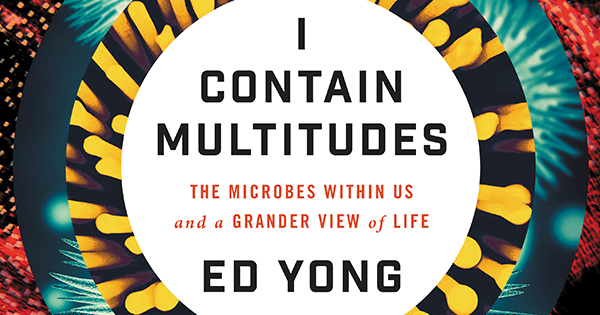I Contain Multitudes
Read an excerpt from Ed Yong’s new book about the microbes within us

For decades, the hygiene hypothesis has posited that the germs we’re exposed to in early childhood can prevent us from developing allergies. And in 2008, the National Institutes of Health followed up its sequencing of the human genome with the Human Microbiome Project, which aims to catalog and characterize all of the microorganisms found in the human body. Still, when most of us think of microbes, we think of germs—and, inevitably, cleansing ourselves of them.
But that’s a terrible idea, writes Ed Yong in his new book, I Contain Multitudes. The microbes inside our bodies shape our organs, break down our food, work in tandem with our immune systems, and even affect our behavior. We’re nothing without our microbes. Get a taste for what these incredible little creatures do for us in this excerpt about the miniature zoos within our own bodies.
When Orson Welles said “We’re born alone, we live alone, we die alone,” he was mistaken. Even when we are alone, we are never alone. We exist in symbiosis—a wonderful term that refers to different organisms living together. Some animals are colonized by microbes while they are still unfertilized eggs; others pick up their first partners at the moment of birth. We then proceed through our lives in their presence. When we eat, so do they. When we travel, they come along. When we die, they consume us. Every one of us is a zoo in our own right—a colony enclosed within a single body. A multi-species collective. An entire world.
These concepts can be hard to grasp, not least because we humans are a global species. Our reach is boundless. We have expanded into every corner of our blue marble, and some of us have even left it. It can be weird to consider existences that play out in an intestine or in a single cell, or to think about our body parts as rolling landscapes. And yet, they assuredly are. The Earth contains a variety of different ecosystems: rainforests, grasslands, coral reefs, deserts, salt marshes, each with its own particular community of species. But a single animal is full of ecosystems too. Skin, mouth, guts, genitals, any organ that connects with the outside world: each has its own characteristic community of microbes. All of the concepts that ecologists use to describe the continental-scale ecosystems that we see through satellites also apply to ecosystems in our bodies that we peer at with microscopes. We can talk about the diversity of microbial species. We can draw food webs, where different organisms eat and feed each other. We can single out keystone microbes that exert a disproportionate influence on their environment—the equivalents of sea otters or wolves. We can treat disease-causing microbes—pathogens—as invasive creatures, like cane toads or fire ants. We can compare the gut of a person with inflammatory bowel disease to a dying coral reef or a fallow field: a battered ecosystem where the balance of organisms has gone awry.
These similarities mean that when we look at a termite or a sponge or a mouse, we are also looking at ourselves. Their microbes might be different from ours, but the same principles govern our alliances. A squid with luminous bacteria that glow only at night can tell us about the daily ebbs and flows of bacteria in our guts. A coral reef whose microbes are running amok because of pollution or overfishing hints at the turmoil that occurs in our guts when we swallow unhealthy food or antibiotics. A mouse whose behavior changes under the sway of its gut microbes can show us something about the tendrils of influence that our own companions insinuate into our minds. Through microbes, we find unity with our fellow creatures, despite our incredibly different lives. None of those lives is lived in isolation; they always exist in a microbial context, and involve constant negotiations between species big and small. Microbes move between animals, too, and between our bodies and the soils, water, air, buildings, and other environments around us. They connect us to each other, and to the world.
Excerpted from I Contain Multitudes: The Microbes Within Us and a Grander View of Life by Ed Yong. Copyright ©2016 by Ed Yong. Reprinted courtesy of Ecco, an imprint of HarperCollins Publishers.

